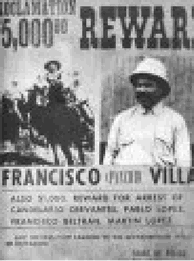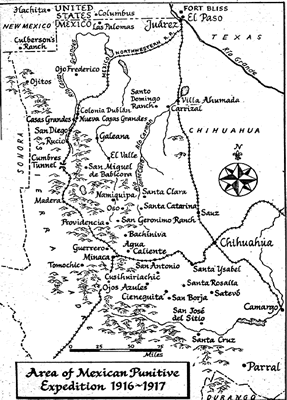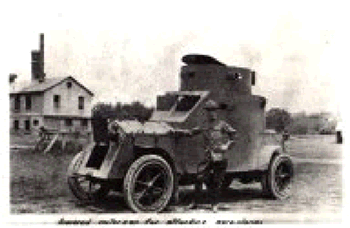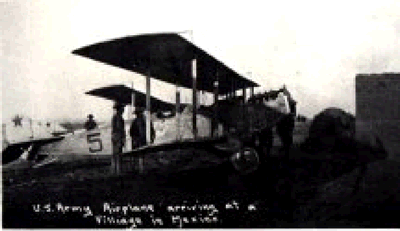
Villa Wanted poster offering $5,000 for his capture

Pancho had made history; his was only the second foreign military attack on
American soil since the British in the War of 1812.
History says that Villa’s reasoning to attack Columbus was that it would
provoke an American invasion into Mexico. This would create a backlash against
Carranza and his friendly ties to the U.S. Therefore; Villa would be ready
in the wings to become the new Mexican national leader.
The day following the attack on Columbus, President Wilson announced he was
sending General John J. Pershing and 5,000 soldiers to Mexico to capture Pancho
Villa. This order was later changed to hunt for Villa, but to cease when his
bands are known to have been broken up.

Within two weeks, Pershing and his men had traveled about 350 miles into Mexico
in Chihuahua. Carranza was hoping Villa would be captured in a quick fashion.
However, he was also worried that Pershing may take this as an opportunity
to start a war with Mexico. This would be a war Mexico would probably come
out as a loser.
This Punitive Expedition, as it was to be called, was working in Villa’s
favor. Many Mexicans were helping him by giving false information to the Americans.
The peons were also notifying Villa of Pershing’s location and direction
of his travel.
By the fall of 1916, Pancho Villa was starting to see some of the mounting
popularity he had planned all along. However, Villa and his men, now numbering
less than 400, were retreating into the mountains of Chihuahua. There were
7,000 U.S. troops after him and they were coming with some modern technology.
Airplanes were now part of the American contingent and they were flying all
over the mountains and nearby deserts in hopes of spotting the elusive Pancho
Villa. His Villastas were now getting worried and starting to lose faith in
their leader.
Carrancistas were also part of the search party and they got into a fight
with Villastas. During the shooting Villa was hit in his knee and he decided
to go into hiding in the nearby mountains. He hid for two months. Villa had
now divided his troops into several units and sent them off into various parts
of Chihuahua and Durango. About 30 troops stayed with Villa.
His units were now fighting the Americans and also the Carrancistas and they
were slowly going down. The Villista generals were being killed and they took
with them, the possibility of making Pancho Villa the national leader he had
hoped for. However, World War I was growing and it was looking more and more
like the U.S. would be entering the conflict very soon.

Americans
tested new military equipment in the expedition, but only kicked up more dust
for Villa to hide behind. No photo credit available.
Some in the Washington had drawn up a plan for the U.S. to just take over
northern Mexico, since Pershing was already there and had demonstrated his
strength with his modern weapons. But the Mexican citizenry and Carranza as
well, were getting a bit tired of the Yankees. President Wilson decided that
there was too much of a possibility of an outright war with Mexico and decided
to pull the American troops back to northern part of Chihuahua. Their main
duty here would be only as an incentive to the Carranza troops, for them to
either kill or catch Villa.
With Pershing not being a serious threat any longer, Pancho Villa was able
to continue speaking out against Carranza and Pershing. His popularity was
continually growing, and on September 15,1916 he surprised everyone by taking
about 2,000 men and attacking the Chihuahua prison, the government and the
Carranza military barracks. His men freed the prisoners, most of which were
his former troops.
The amazing part of this battle is that there about 10,000 American troops
and 9,000 Carrancistas in the town at the time. Villa’s troops suffered
minor losses. His popularity soared even higher after word went out of what
he had accomplished. He then began openly attacking Carrancistas and defeating
them most of the time.
By August 1916, the U.S. had sent 111,000 troops to the border to track down
Villa. They were never able to even come close to catching Villa. In February
1917, Gen. Pershing and his army had decided to call it quits and go back
to the states without punishing Villa. Very few fights actually took place
between the Villistas and the American troops.

Besides all of his trucks, motor cars, motor cycles, and armored
cars, Pershing also mustered dirigble baloons and airplanes in his relentless
quest to find Villa. No photo credit available.
The Punitive Expedition was now considered to be a failure since they never
caught Villa. However, it could also be considered a success if the aim was
to keep Villa away from the U.S. border and not allow him to invade America
again. This had also been a good place and time to experiment with the new
military weapons in preparation for the war in Europe against the Germans.
This invasion also proved good training for military leaders, including George
S. Patton, who would later lead U.S troops to victory in Europe.
Katz, Freidrich, Katz. The Life and Times of Pancho Villa. Stanford University Press, 1998.
 Legends
Before the Revolution
Legends
Before the Revolution
 Revolutionary
Hero
Revolutionary
Hero
 Attack
on Colombus, NM
Attack
on Colombus, NM
 Return
to Jaime's Home Page
Return
to Jaime's Home Page